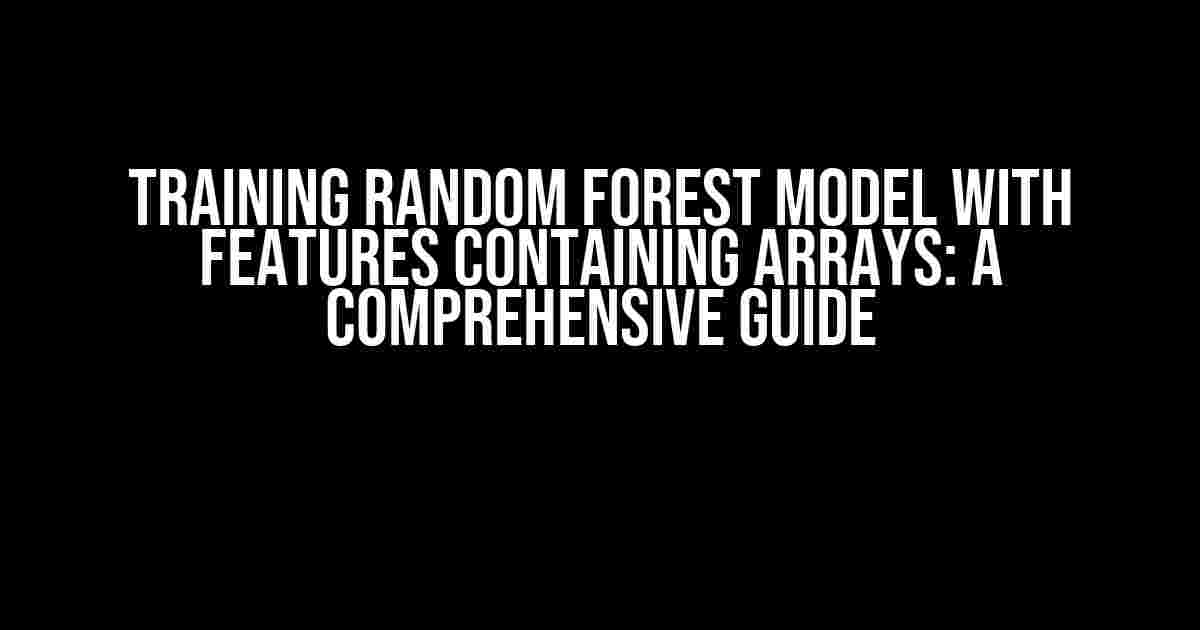Are you tired of struggling with array-based features in your machine learning models? Do you want to unlock the full potential of random forest models with features containing arrays? Look no further! This article will take you on a step-by-step journey to master the art of training random forest models with features containing arrays.
What are Array-Based Features?
Array-based features are a type of feature that contains multiple values or elements within a single column. These features are common in datasets where multiple measurements or observations are taken for a single instance. Examples include:
- Time-series data (e.g., sensor readings, stock prices)
- Image or audio features (e.g., pixel values, spectral coefficients)
- Text data (e.g., word embeddings, sentence embeddings)
These array-based features can be challenging to work with, especially when it comes to training machine learning models. However, with the right techniques and tools, you can unlock their full potential.
Why Use Random Forest Models?
Random forest models are a popular choice for many machine learning tasks due to their:
- Accuracy: Random forest models can achieve high accuracy with the right hyperparameters.
- Interpretability: Random forest models provide feature importance scores, making it easy to identify key predictors.
- Flexibility: Random forest models can handle both categorical and numerical features.
- Scalability: Random forest models can handle large datasets with ease.
However, traditional random forest models struggle with array-based features. That’s where we come in – to guide you on how to train a random forest model with features containing arrays.
Preparing Array-Based Features for Random Forest Models
Before we dive into training the random forest model, we need to prepare the array-based features. Here are some common techniques:
1. Flattening Arrays
One approach is to flatten the arrays into separate columns. This can be done using the following Python code:
import pandas as pd # assume 'df' is your DataFrame with array-based features flat_df = pd.DataFrame(df['array_feature'].tolist(), columns=['feature_0', 'feature_1', ...])
This method can lead to a high-dimensional feature space, which may require dimensionality reduction techniques.
2. Feature Extraction
Another approach is to extract meaningful features from the arrays. For example, you can calculate:
- Mean or median values
- Standard deviation or variance
- Skewness or kurtosis
- Frequency-domain features (e.g., Fourier transform)
This method reduces the dimensionality of the feature space and may improve model performance.
3. Array-Based Feature Encodings
Some libraries, such as numpy and scikit-learn, provide array-based feature encodings. For example:
from sklearn.preprocessing import MultiLabelBinarizer # assume 'df' is your DataFrame with array-based features mlb = MultiLabelBinarizer() encoded_features = mlb.fit_transform(df['array_feature'])
This method can help preserve the original information in the arrays.
Training a Random Forest Model with Array-Based Features
Now that we have prepared the array-based features, it’s time to train our random forest model. Here’s a step-by-step guide:
1. Import Necessary Libraries
First, import the necessary libraries:
import pandas as pd from sklearn.ensemble import RandomForestClassifier from sklearn.model_selection import train_test_split from sklearn.metrics import accuracy_score
2. Split Data into Training and Testing Sets
Next, split your dataset into training and testing sets:
X = df.drop('target', axis=1)
y = df['target']
X_train, X_test, y_train, y_test = train_test_split(X, y, test_size=0.2, random_state=42)
3. Initialize and Train the Random Forest Model
Now, initialize and train the random forest model:
rf_model = RandomForestClassifier(n_estimators=100, random_state=42) rf_model.fit(X_train, y_train)
4. Evaluate the Model
Finally, evaluate the model using the testing set:
y_pred = rf_model.predict(X_test)
print('Accuracy:', accuracy_score(y_test, y_pred))
Tuning Hyperparameters for Random Forest Models with Array-Based Features
Hyperparameter tuning is crucial for any machine learning model. Here are some tips for tuning hyperparameters for random forest models with array-based features:
1. n_estimators
The number of trees in the random forest model can significantly impact performance. Try values between 10 and 100.
2. max_depth
The maximum depth of each tree can also affect performance. Try values between 3 and 10.
3. min_samples_split
The minimum number of samples required to split an internal node can impact model performance. Try values between 2 and 10.
4. min_samples_leaf
The minimum number of samples required to be at a leaf node can also impact model performance. Try values between 1 and 5.
Use techniques like grid search or random search to find the optimal hyperparameters for your model.
Common Challenges and Solutions
Training a random forest model with array-based features can come with its own set of challenges. Here are some common issues and solutions:
1. Handling High-Dimensional Feature Spaces
Solution: Use dimensionality reduction techniques like PCA or t-SNE to reduce the feature space.
2. Dealing with Class Imbalance
Solution: Use class weighting or oversampling techniques to balance the classes.
3. Handling Missing Values
Solution: Use imputation techniques like mean or median imputation to fill in missing values.
Conclusion
Training a random forest model with features containing arrays can be a challenging task, but with the right techniques and tools, you can unlock their full potential. By following this comprehensive guide, you’ll be able to prepare array-based features, train a random forest model, and tune hyperparameters for optimal performance. Remember to experiment with different techniques and evaluate your model thoroughly to achieve the best results.
| Keyword | Related Concepts |
|---|---|
| Training Random Forest Model | Machine Learning, Feature Engineering, Hyperparameter Tuning |
| Features Containing Arrays | Array-Based Features, Feature Extraction, Dimensionality Reduction |
| Random Forest Models | Decision Trees, Ensemble Learning, Bagging |
By mastering the art of training random forest models with features containing arrays, you’ll be able to tackle complex machine learning tasks with confidence. Happy learning!
Frequently Asked Question
Get the inside scoop on training a Random Forest model with features containing arrays – the do’s, the don’ts, and the what-ifs!
Q1: Can I directly pass an array as a feature to a Random Forest model?
No, you can’t directly pass an array as a feature to a Random Forest model. Random Forest models require numerical or categorical features, not arrays. You’ll need to unpack or flatten the array into individual features or use techniques like bag-of-words or feature extraction to convert the array data into a suitable format.
Q2: How do I handle arrays with varying lengths when training a Random Forest model?
When dealing with arrays of varying lengths, you’ll need to pad or truncate them to a fixed length. You can use techniques like zero-padding, padding with a specific value, or using a maximum length cutoff. Alternatively, consider using techniques like attention mechanisms or recurrent neural networks (RNNs) that can handle variable-length input sequences.
Q3: Can I use techniques like one-hot encoding or label encoding on array features for a Random Forest model?
Yes, you can use one-hot encoding or label encoding on array features, but it’s essential to unpack or flatten the array first. This will create a new feature for each unique value in the array, allowing the Random Forest model to treat them as individual features. However, be cautious of the curse of dimensionality and consider using techniques like feature selection or dimensionality reduction to avoid overfitting.
Q4: How do I decide which array features to include or exclude when training a Random Forest model?
To decide which array features to include or exclude, evaluate the feature importance using techniques like permutation importance or SHAP values. This will help you identify the most relevant features and eliminate those with low importance. Additionally, consider using feature selection techniques like recursive feature elimination (RFE) or correlation-based feature selection to reduce the dimensionality of your feature space.
Q5: Can I use Random Forest models with array features for time-series forecasting or sequence prediction tasks?
While Random Forest models can handle array features, they’re not the most suitable choice for time-series forecasting or sequence prediction tasks. Consider using models like LSTM, GRU, or transformers that are specifically designed for sequence data. However, if you still want to use Random Forest, make sure to carefully preprocess your array features and consider techniques like time-series decomposition or feature extraction to prepare your data for modeling.


